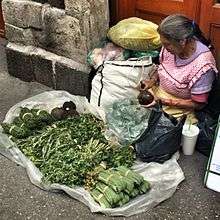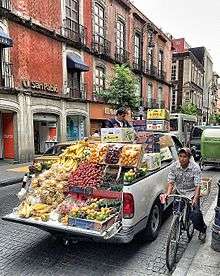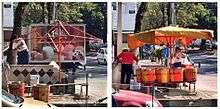Street vendors in Mexico City





The presence of Street vendors in Mexico City (known locally in Mexican Spanish as ambulantes) dates back to pre-Hispanic era and over the centuries the government has struggled to control it, with most recently a clearing of downtown streets of vendors in 2007, but despite this there is a persistent presence of many thousands illegally.[1] In 2003 it was estimated that there were 199,328 street vendors in Mexico City.[2]
History
Prior to the Spanish conquest of the Aztec Empire, commercial activity primarily took place in the tianguis or marketplaces. In New Spain, outside of the controlled mercado or market on the Zócalo and other squares, street vendors emerged, then called buhoneros. Efforts to control street vendors date back to at least 1541, when the city government prohibited itinerant vendors.[3][4]
The 1970s and 1980s saw huge growth in the number of vendors.[5]
In 1993 the first of several major efforts (each only partially successful) to reduce street vending in the Historic Center of Mexico City began, with the removal of about 10,000 vendors from the streets and construction of markets (plazas comerciales) to reaccommodate them, as well as subject them to tax codes, health regulations and otherwise pay the full "costs of formality."[5][6]
In 1998 guidelines attempting to formalize and bring order to the sector were published as the Programa de Reordenamiento del Comercio en Via Publica, or Program for the Reordering of Trade in the Public Streets,[5] however street vending continued to grow.[2] Efforts to remove the vendors eventually failed as vendors returned to the streets. During the 1990s and 2000s street vendors have paid union leaders "dues" in exchange for the right to occupy a piece of sidewalk without city permission, an illegal act. The unions in turn, bribed and lobbied city officials to allow the vendors to stay.[7]
Finally, in October 2007 the streets of the Historic Center were cleared of vendors with much success, which was considered a victory for mayor Marcelo Ebrard.[7] However, toreros (literally "bullfighters") remain active in the area — people who sell merchandise from a tarp on the ground which converts to a bag that they can carry the merchandise in and carry it away when police show up to clear illegal street vendors.[1]
Types of street vendors and products
Street vendors in a variety of formats, with items sold from:[8]
- baskets, particularly sandwiches, tacos,
- pushcarts, particularly prepared fruit and coconut water
- the backs of trucks (lorries), particularly fruit and toilet paper
- a tarp or cloth laid on the ground
- stalls
Vendors selling from stalls may be organized into a number of formats:
- tianguis and mobile markets (mercados sobre ruedas): These markets take place in a designated place on certain days of the week, with a fixed schedule and supervised by a city inspector for compliance with weights and measurements. These markets are part of the strategy for the supply and distribution of food staples to the city.[9]
- Concentrations: areas of vendors selling from stalls, not officially organized, specializing in certain types of products, such as imported illegal merchandise or fayuca, especially electronics, in Tepito, or auto parts, tools, clothing, etc.[9] Although in many cases those selling from stalls are not truly itinerant (ambulante, in Spanish) - they are still referred to as ambulantes. Concentrations of stalls are also found at metro station entrances, near hospital entrances etc.
- Bazaars (plazas comerciales), where vendors of a certain "theme" (stationery) are housed; originally these were organized to accommodate vendors formerly selling on the street
- Individual or small groups of stalls on any given city sidewalk
Numbers
A 2013 study revealed just in the Historic Center of Mexico City:[1]
- 25,000 vendors
- 150 blocks of the Historic Center where informal vendors were present
- 70% of the toreros coming from the State of Mexico
- 60 organizations controlling the vendors
A 2003 INEGI study showed 199,328 street vendors in Mexico City proper (Mexican Federal District).[2]
A study in the mid-1990s had estimated the number of street vendors as follows:
- Total full-time street vendors: 185,600. This number excludes those who occasionally sell in the street or who add to the numbers during peak commercial seasons, and the study estimated that if included they would probably add at least 50 per cent to the figure.
- Concentrations: 1,500 stalls on the street or sidewalks (not counting 10,500 stalls in empty lots) Rotating Markets: 38,000 stalls
- Ambulatory: 67,248 stalls
- Metro stations: 5,000 stalls
- Street corners/neighbourhoods: 10,000
- Total stalls: 121,738.
– Source: [10]
References
- 1 2 3 "“Toreros”, un mal del Centro Histórico", Más por Más", February 18, 2013
- 1 2 3 Redes sociales y comercio en vía pública en la Ciudad de México, Norma Gómez Méndez
- ↑ Los orígenes del comercio ambulante en la Ciudad de México (PDF), UNAM, p. 53
- ↑ Martha de Alba, El ambulantaje en imágenes : una historia de representaciones de la venta callejera en la Ciudad de México (siglos XVIII-XX)
- 1 2 3 John C. Cross, Ph.D. (January 1995), FORMALIZING THE INFORMAL ECONOMY: THE CASE OF STREET VENDORS IN MEXICO CITY, The American University in Cairo
- ↑ Los Angeles Times, "Changing Lifestyles : Wanted: Place to Relocate 10,000 Street Vendors", October 19, 1993
- 1 2 Los Angeles Times, "Vendor-free zone in Mexico City center", October 13, 2007
- ↑ Reporte Temático No. 2: Comercio Ambulante (PDF), Cámara de Diputados (Mexico), Centro de Estudios Sociales y de Opinión Pública, June 2005
- 1 2 Sergio Peña (1999), Informal Markets: Street Vendors in Mexico City (PDF), Florida State University
- ↑ John C . Cross, Informal Politics: Street Vendors and the State in Mexico City, (Standford, California, Stanford University Press, 1998) as quoted in WOMEN AND MEN IN THE INFORMAL ECONOMY : A statistical picture (PDF), International Labour Organization, 2002
External links
| Wikimedia Commons has media related to Street vendors in Mexico, D. F.. |